Four Examples: Schools Aquaponic Teaching Tools
Example 1:
Name: BTI Aquaponics, Baker Technical Institute
Location: Baker City, Oregon, USA
Climate Zone: 5 (note: system is indoors)
Square Footage: 1,500
Cost: $6000
Concept Description: BTI Aquaponics is a year-long high school STEM/CTE course that is apart in the Environmental Science career learning pathway at Baker Technical Institute, in Baker City, Oregon.
School Contact: Burke Smejkal
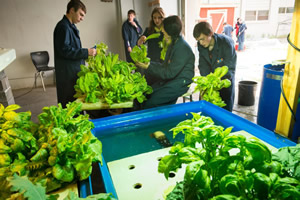
Baker Technology Institute
Students harvesting aquaponically-grown lettuce that will be used in the school lunch program at Baker Technical Institute, Baker City, OR.
BTI Aquaponics is a year-long high school STEM/CTE course that is apart in the Environmental Science career learning pathway at Baker Technical Institute, in Baker City, Oregon. The curriculum uses principles of STEM education with applied contexts in water quality and chemistry monitoring, plant and fish sciences, sustainable agriculture, food safety, global food security, local food production, and agricultural and biological engineering. The program goal is to provide students a practical foundation in the areas of aquaculture, hydroponics, and aquaponics so that they can pursue further education and/or job training in careers related to agriculture, science and engineering. Students entering the course will have taken the Introduction to Aquaculture course in which they learn basics in water quality, fish biology, and controlled environmental agriculture.
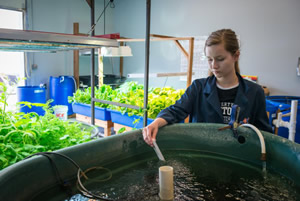
Baker Technology Institute
Water quality testing is an essential part of aquaponics food production. Here, a student in the BTI Aquaponics program checks temperature.
During the course of the year BTI Aquaponics students have four notable and unique educational experiences: 1) Build a business model in collaborative groups to produce basil, mint and kale for two local businesses and the school cafeteria. They see this process through from seed to customer and focus on building the soft skills related to meaningful business relationships. 2) Research, design and build an aquaponic system from scratch to provide edible products using principles of engineering. 3) Explore careers in three distinct, but related fields to aquaponics. Students spend a day with fish biologists and environmental technicians of the Oregon Department of Fish and Wildlife; they take a tour of our local hydroponic and nursery businesses; and an video interview and facility tour with Rebecca Nelson of Nelson and Pade Aquaponics, highlighting the innovative field of aquaponics. 4) Participate in service learning experiences with our local watershed council, job shadows with our regional career partners, and summer internships in the field with supporting local agencies.
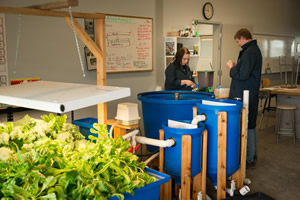
Baker Technology Institute
Students weighing fish feed and conducting feed calculations for the fish in the F5 Clear Flow Aquaponics System® at Baker Technical Institute.
Burke Smejkal is the teacher responsible for building and designing the Aquaponics program at BTI. While studying STEM education and designing courses, Burke found the exciting and innovative field of Aquaponics as a natural fit. After taking Nelson and Pade’s Master Aquaponics Class™ and a corresponding UWSP course, Burke had the inspiration and knowledge base to feel confident enough to start a course of his own at BTI using the Nelson and Pade F5 system as the foundation for teaching and learning about Aquaponics.
Other Highlights:
- Breeding our own Tilapia
- Aligning course standards to the NGSS
- Kale and salad mixes to our school cafeteria
- Give facility tours for all ages of students and community members
- End of the year fish fry and salad feast fundraiser
Example 2:
Name: AguaLab, Canton Elementary STEM Academy
Location: Canton, Georgia, USA
Climate Zone: 7a (note: system is indoors)
Square Footage: 800 Cost: $4000
Concept Description: The AGUA Lab consists of a sustainable living ecosystem of dozens of fish and plants. NXT robots and Vernier Scientific probes combine to create a dynamic way to teach STEM by incorporating easy-to-use data loggers, sensors, experiments, and graphing/analysis software into the hands of students, helping educators develop the next generation of scientists and engineers.
School Contact: Judy Wright
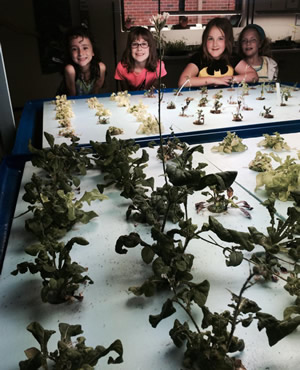
Courtesy of Canton Elementary STEM Academy
Proud students showing the young plants growing in their F5 Clear Flow Aquaponic System® at Canton Elementary School, Canton, OH. The fish, swimming in a separate tank, eat food and excrete waste, which is broken down to the individual elements the plants need by beneficial bacteria.
At Canton ES STEM Academy, student learning and achievement undergoes a transformation from the ordinary to the extraordinary, as students enter and engage in a world of their own imagination, driven by Common Core State Standards and STEM fields. Under the lens of STEM, 21st century learning marries content and practice, as Canton’s teachers seek new ways to prepare students to thrive in a new world, as yet not envisioned. STEM lessons are developed by teachers and then modified to meet the needs of our students and their community. Our curriculum embraces the essence of STEM and has become at its heart the integration and application of science, technology, and engineering in ways that encourage students to become active creators of content, rather than passive recipients of knowledge.
At the core of our STEM integration program is our Aquaponics “AGUA” Lab. With the help of a grant the Canton Rotary Club and Donor’s Choose, the AGUA lab is the only aquaponics system in the Cherokee County School District and one of only a half dozen such systems used in Georgia Schools. The AGUA Lab consists of a sustainable living ecosystem of dozens of fish and plants. NXT robots and Vernier Scientific probes combine to create a dynamic way to teach STEM by incorporating easy-to-use data loggers, sensors, experiments, and graphing/analysis software into the hands of students, helping educators develop the next generation of scientists and engineers.
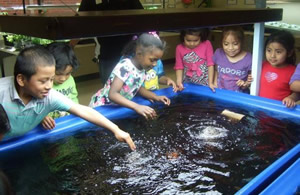
Courtesy of Canton Elementary STEM Academy
Students are preparing to add plants to the aquaponic system at the Agua Lab at Canton Elementary School. Plants will float on rafts on the surface of this tank, with the roots dangling into the aerated, nutrient-rich water.
Canton ES STEM Academy pursues every opportunity to integrate rigorous curriculum content from within the context of designing solutions to real-world problems that pique the curiosity of students while establishing a foundation for success for the school and staff alike. We expect every one of our students to want to learn and more importantly to understand as they create a world of their own making and discover that their dreams are only limited by the reach of their imagination.
Example 3:
Name: Washburn High School Aquaponic Program
Location: Bayfield Peninsula, Washburn, WI
Climate Zone: 4b (note: system is in a greenhouse)
Square Footage: 1000 Cost: $8,000
Concept Description: Washburn High School, located on the Bayfield peninsula in northern Wisconsin, recently made progress on a great initiative in its school bringing a novel and innovative concept into its classroom, aquaponics.
School Contact: Sean Augustyn
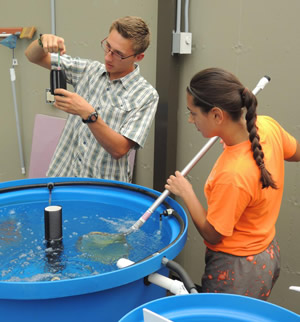
Washburn High School students maintain their F5 Clear Flow Aquaponic Systems®, learning water chemistry, biology, and engineering in the process.
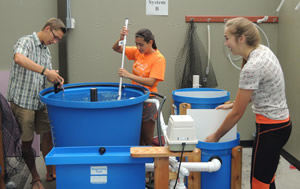
Water quality testing, sample fish weights, and filter tank maintenance are some of the hands-on learning processes in the aquaponics program at Washburn High School, Washburn, Wisconsin.
Narrative:
Washburn High School, located on the Bayfield peninsula in northern Wisconsin, recently made progress on a great initiative in its school bringing a novel and innovative concept into its classroom, aquaponics. Over the last year and a half the school has designed and built an aquaponics greenhouse, currently with two of Nelson & Pade’s F5 systems. Since its construction, students have been abuzz with anticipation to find out what all this is truly about. Most of the aspects of the aquaponics systems were put together by students, which offered a great opportunity for the technology education department. The system was first used in a semester long course where students participated in a hands-on project based class. Here the students were able to explore the techniques and practices associated with aquaculture as well as hydroponics. The students focus was on maintaining the harmonious balance of various nutrients, bacteria, and gasses within the system. They had the opportunity to take the daily measurements of dissolved oxygen and pH, measure the growth of fish, and all the while getting to see delicious lettuce grow. This year the class is shifting slightly to a hands-on, project based class, but with an integral research component. The students will be expected to maintain the system, but will be challenged to find an area of science that interests them and relate it to aquaponics. For example, one of the students has expressed an impressive interest in entomology, and will be researching sustainable and environmental pesticides and other pest control techniques. With aquaponics, there is a wonderful opportunity for bringing together many facets of education, from mathematics and technology, to biology and ecology. In the back of our classroom, we have an interesting controlled ecosystem providing great experiences for students, who become hooked as soon as they walk in the room.
Example 4:
Name: Safe Harbor Academy
Location: Versailles, KY
Climate Zone: 6a (note: system is in a school)
Square Footage: 300 Cost: $4,000
Concept Description: Safe Harbor Academy is a transitional alternative learning environment (within Woodford County Public Schools) in Versailles, KY. The students and faculty of Safe Harbor Academy are integrating project based learning (PBL) through Aquaponics and other initiatives. The hands-on aquaponics program is intertwined to support student achievement and understanding to the true depths of all contents standards.
School Contact: Logan Culbertson, principal; Aquaponics Project Manager: Sarah Patton
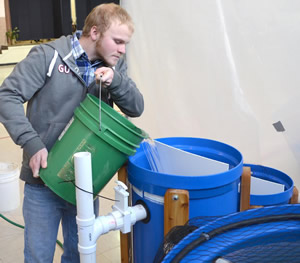
Courtesy of Safe Harbor Academy
Gavin Rogers maintaining the filter tanks in the F5 aquaponic systems at Safe Harbor Academy. Photograph Credit: Bob Vlach; Woodford Sun
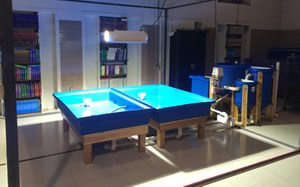
Courtesy of Safe Harbor Academy
The F5 (Fantastically Fun Fresh Food Factory) Clear Flow Aquaponics System at Safe Harbor Academy
Safe Harbor Academy is a transitional alternative learning environment (within Woodford County Public Schools) in Versailles, KY. Our Purpose statement: Safe Harbor Academy in partnership with young adults, families, and community will prepare all students to strive for excellence through rigorous instruction and support to become college, career, and life ready citizens. We serve students through a structured approach to best support academic and behavior needs. The students and faculty of Safe Harbor Academy are integrating project based learning (PBL) through Aquaponics and other initiatives. The hands-on aquaponics program is intertwined to support student achievement and understanding to the true depths of all contents standards. Our employability system (student transition process) is also interwoven through the daily maintenance and upkeep of the Nelson and Pade F5. The employability system provides students feedback and data based on their positive decision making throughout the week. We collaborated with local businesses to determine what are the skills, characteristics, and traits of successful employees across several niche markets. We took this feedback and integrated it into our culture of TRUST. Aquaponics is a “hands on holistic platform” that allows us to reinforce positive employability skills, life/social skills, and healthy food choices.
Aquaponics Lessons Learned:
- Use a science based-system. There is a great deal of research and development that has moved aquaponics from a concept to an industry. If you are going to be successful, emulate success with a science-based system.
- Feed a quality fish feed. Your fish need a balanced diet to grow and be healthy. If your fish aren’t healthy, you will struggle with fish health issues and not generate the nutrients your plants need. A successful aquaponic system starts with healthy fish.
- Know your inputs. The primary inputs to an aquaponic system are fresh water, quality feed and energy to run an aquaponic system. Other inputs include seeds, biological pest control. All inputs need to be compatible with the fish, beneficial bacteria, and plants.
- Provide proper environmental control. The best aquaponic system will not work if proper environmental control is not in place. You need to provide light, ventilation and the proper air and root temperature for the plants and the proper water temperature and quality for the fish.
- Don’t mix a soil system with a soilless system. Soil harbors pests and disease that can be harmful to your plants. Don’t bring soil into a soilless system.
- Use food-grade materials. Aquaponics is a food production system. Use food grade materials. Follow food safety protocols.
- Use a proven system. Buying and assembling a proven system will get the project off to a good start and will have long-term, positive results. Homebuilding often results in a system that is not productive, does not demonstrate the true science of aquaponics and, in the end, fails.
- Raise funds. A well-designed aquaponic system will produce food (vegetables and fish) that you can sell. Use these funds to help cover expenses of operating the system.
- Collaborate with other teachers. Aquaponics is the ultimate interdisciplinary teaching tool. You use math, engineering, chemistry, science, business, agriculture, horticulture, biology, botany, health, nutrition and more! Work with other teachers for an all-inclusive learning experience.
- Encourage students to take responsibility. In addition to the entire core curriculum; subjects listed above, aquaponics teaches responsibility as students care for the fish and plants.
Benefits of Aquaponic Food Production
- Both fish and vegetables are raised in one integrated system with less water and fewer resources than traditional agriculture.
- Plants are raised using an all-natural fertilizer, without the use of chemical fertilizers.
- There are no pesticides or herbicides used.
- Growing plants without soil eliminates soil borne disease and pest insects that dwell in the soil.
- You can grow more food in a given space than traditional agriculture.
- Fish are cold-blooded and don’t harbor the same pathogens (such as salmonella and e-coli) as warm blooded animals.
- Fish produce CO2, plants need CO2.
- You produce a protein and vegetables crop in the same system.
- Aquaponics, when combined with a controlled environment, can produce fish and vegetables 365 days per year, anywhere in the world.
- Vegetables can be sequentially planted and continuously harvested.
Steps for Implementation of K-12 Aquaponics Closed Loop Teaching Tool
- Examine the infrastructure you have. You will need space with a flat floor, a drain, fresh water, light, ventilation, and air temperature control.
- Determine the space you have to work with. It can be a countertop in a classroom, a vacant space in a classroom, an unused room in a school, an existing greenhouse or a space that a greenhouse can be built.
- Select a system that fits in the space you have. From an aquarium-based desktop system to a small commercial unit, schools have started with a variety of sizes.
- Determine purchase and startup costs. Know what it will cost before you start so you can seek the correct funding.
- Get the team onboard. Talk to the administration and fellow teachers about what you will achieve and demonstrate with aquaponics as well as discuss the required inputs and costs. Approach the aquaponics project as a team effort.
- Get educated. Aquaponics is a fascinating method of food production. Take a class from professionals and read a book published by professionals to learn the science, methodology and design parameters before you start teaching.
- Understand the returns. The returns are multi-fold and come from the diverse learning opportunities, responsibilities, awareness of life cycles and nutrition and the sale of fish and vegetables.
- Seek funding. The smallest system might costs a couple of hundred dollars. Larger, more productive systems can cost in the thousands. Typically, in addition to the learning, the Clear Flow Aquaponic Systems® have an ROI of 3-4 years.
- Order the system. Place your order for the system, seeds and any accessories.
- Prepare your space. While waiting for the system to arrive, prepare your space and make any infrastructure changes necessary.
- Assemble the system. Once the system arrives, assemble it, or have someone available who can. It usually takes some basic plumbing and building skills.
- Add fish. Most schools raise tilapia, a fast-growing, hardy fresh water fish.
- Cycle the system. Once you have fish, you will see the nitrification process happen. This is a great learning tool in itself, as the beneficial bacteria establish themselves in the system and convert ammonia to nitrite and nitrite to nitrate.
- Add plants. Once the system has initially cycled, you can start adding plants. Start plants from seed to reduce the potential of plant disease.
- Begin harvesting plants. Fast growing plants like lettuce and beans are a great choice for school systems because results happen quickly, with fresh vegetables available for students to eat or sell.
- Harvest the fish. At the end of the school year you can have a fish fry or sell the fish as a fundraiser.
Return to Teaching Tools for K-12; Aquaponics, Aeroponics, and Closed Loop Food Systems
This article originally appeared in the issue of .